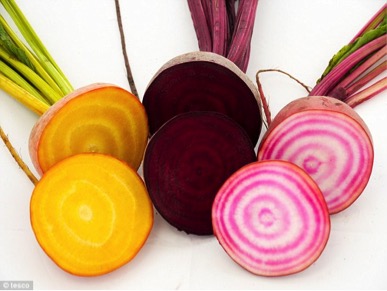I’ve always loved Beetroot! As a kid, the colour and sweet flavor attracted me to them; I loved to have the baby beets in salad, just by themselves, and especially sliced on a burger with the lot! My sister was the same; I remember one occasion when we were quite young, we were out to dinner at a venue that had a complimentary salad bar, which included one giant bowl of baby beets. My sister ate so many beets that night that her urea and stool was red the following morning!
 After doing some research I found that this is due to the Betacynanin pigment (colour compound), Betanin[i], found in Beetroots. Betanin is used by the body to assist certain processes but it is not fully broken down. This means that in high concentrations it can cause the urea and stool to become red – understandably distressing if you’re not expecting it! But it’s completely harmless and will subside once the betanin is out of the system.
After doing some research I found that this is due to the Betacynanin pigment (colour compound), Betanin[i], found in Beetroots. Betanin is used by the body to assist certain processes but it is not fully broken down. This means that in high concentrations it can cause the urea and stool to become red – understandably distressing if you’re not expecting it! But it’s completely harmless and will subside once the betanin is out of the system.
1. The shear abundance of nutrients and antioxidants
In addition to giving beets their brilliant colour, betanin is a great antioxidant. Antioxidants help prevent oxidative reactions in our bodies by scavenging up free-radicals1 (if not scavenged up free radicals can react and interfere with normal bodily processes causing damaged cells and diseases). This essentially helps the body to ‘detox’, preventing illness and even cancers.
Beets have a really great variety of vitamins and minerals[ii]; immune boosting vitamin C, potassium, magnesium (aids in muscle function), folate and folic acid (vital for pregnant women). And don’t throwing out the leaves attached to your bundle of beets. Amazingly, beetroot leaves have more iron than Spinach! So waste-not-want-not; eat your Beet leaves too!
For the full nutritional breakdown of beetroot, click here.
2. Beetroots can help to Lower Blood Pressure
Several studies have shown that ingesting beetroot has had a beneficial effect on lowering blood pressure. It is known that the presence of Nitric Oxide in the blood signals smooth muscle in the arteries, which in turn triggers vasodilation (widening) of the blood vessel walls and increased blood flow (hence, lowering blood pressure).2
A large amount of dietary nitrates are found in beets, which are thought to metabolise into Nitric Oxide in the blood, enabling the vasodilation described above.[iii]
3. Stamina and Athletic Performance
In the same way that dietary nitrate has the ability to lower blood pressure (above) it also has benefits for athletes. Firstly, the improved blood flow to the muscles created by the vasodilation of the arteries means that more blood, and oxygen, is able to get to the muscles, improving energy conversion. It is also hypothesized that the nitric oxide formed from the nitrates may reduce the oxygen cost of low-intensity exercise as well as enhance the tolerance to high-intensity exercise3.
The Potassium and Magnesium in Beetroot also aid in muscle and nerve function.
4. Digestion
The fibre content of Beetroots help to prevent constipation and regulate a normal digestive tract.
5. Inflammation
The antioxidants in addition to the nitrates found in beets help to ease inflammation by absorbing damaging free-radical molecules in the body and increasing blood flow.
6. It makes dishes look great!
Purple is definitely my favourite beet colour and definitely adds a zing to the look of any dish! However beets also come in a pink/white striped variety as well as golden. The golden beetroot gives a beautiful, buttery flavor when roasted, while I find the pink/white is best eaten raw in salads.
Beetroot can be eaten boiled, roasted, steamed, pickled, fried, grilled, raw, any way you like, really. Here are some suggestions below
- PB Lifestyles Beetroot Bircher Muesli (the sweet flavor of Beetroot lends itself really well to this dish)
- PB Lifestyles Beetroot and Horseradish Dip
- Grated in cakes and brownies (similar to carrots in carrot cake)
- In juice or smoothies
- Raw, grated in salads
- Roasted (my favourite way to roast beetroot is to wrap the whole thing in al-foil and bake for 40-50mins on 180degC. By wrapping it in alfoil I find the vegetable doesn’t dry out).
- Serve roasted beetroot as a side with other roasted veges, throw it through a salad or slice it and have on a sandwich.
- Sliced raw and used to dip in hommus/tzatziki or your favouite Dip
- Add to a sauerkraut mix for extra nutrients.
- In soups like the Polish Borscht.

Beetroot and Horseradish Dip
[i] Nottingham. S, 2004, Beetroot, http://www.stephennottingham.co.uk/beetroot.htm, accessed 10/3/15
[ii] Ware, M. 2014, What are the health benefits of beetroot?, Medical News Today http://www.medicalnewstoday.com/articles/277432.php accessed 10/3/15
[iii] Mercola, Benefits of Beets, 2014 http://articles.mercola.com/sites/articles/archive/2014/01/25/beets-health-benefits.aspx accessed 10/3/15


